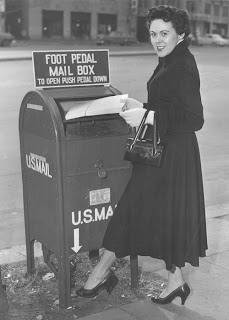Did you know that Benjamin Franklin was this country’s first Postmaster General in 1775? Or that back in November of 1958, New York jeweler Harry Winston used the United States Postal Service to send the 45.52-carat Hope Diamond to the Smithsonian Institution in Washington. D.C.? (It cost him $2.44 for postage and $142.85 for $1 million worth of insurance.) How about the fact that the JW Westcott, a 45-foot contract mail boat that delivers mail to passing ships in the Detroit River, has its own zip code? (There are more than 42,000 zip codes in the country; the JW Westcott’s is 48222.)
It’s also interesting to note that postage cost 2 cents/ounce back in July of 1885. It had risen to 10 cents by March of 1974, a quarter in April of 1988, and currently costs just 44 cents to mail a standard size letter anywhere in the country. For more than two centuries, the United States Postal Service has been committed to one principle: Everybody in this country, no matter who or where, has the right to equal access to secure, efficient and affordable mail service.
A few more factoids: the USPS processed 171 billion pieces of mail last year. It processes an average of 563 million pieces each day – an average of 23 million/hour – and is the second largest civilian employer in the country, with 574,000 career employees. It accepted 6.7 million passport applications and issued 123.6 million money orders last year, delivers 40 percent of the world’s mail, and doesn’t receive a dime of tax revenue.
That’s right. The USPS – which reaches every address in the nation, 150 million residences, businesses and post office boxes – is self-supporting, relying on the sale of postage, products and services to fund its operations.
This is why it bugs me that the USPS is moving forward with plans to close more than 300 processing centers nationwide next year (including facilities in six Michigan cities, among them Lansing, Jackson and Kalamazoo) and several thousand post offices. This is expected to cost 1,400 jobs in my state alone.
Why? Because of a federal law forcing the organization to overpay into its employee retirement system. That’s why it’s losing billions each year – not because of the advent of e-mail or package delivery competition.
According to the Save the Post Office web site, the USPS “has overpaid into the Civil Service Retirement System (CSRS) by as much as $75 billion, as well as overpaying into the Federal Employees Retirement System (FERS) by about $6.8 billion (as of FY 2009). Combined, these overpayments amount to about $82 billion. If a significant portion of these overpayments were returned to the Postal Service, the ‘crisis’ would vanish in a flash.”
The website points out that “the 2006 Postal Accountability and Enhancement Act (PAEA) is causing most of the current ‘crisis’ by requiring employees to pay over $5 billion each year into a fund that will pay for future health benefits of retirees in the next 75 years. If USPS had not been required to prepay these benefits, the organization would be in the black by $1.5 billion as of June 2011. Even with the $10 billion deficit being projected for FY 2011, the USPS would be in the black by $2.5 billion by the end of the fiscal year.”
 |
| Joe Lieberman |
Surprisingly, Connecticut’s Joe Lieberman, who chairs the Senate Homeland Security and Governmental Affairs Committee (and is one of my all-time least favorite politicians), is taking a break from his efforts to undermine the president by sponsoring legislation to encourage as many as 100,000 postal employees to quit or retire in the next few years, lower the organization’s annual health care bill by billions and promote enrollment in Medicare, among other provisions.
I can’t believe I’m hoping Joe Lieberman will actually succeed at something.
I haven’t read Lieberman’s bill, known as the “21st Century Postal Service Act of 2011,” but if it saves the post office, I’m for it.
By the way, the Save the Post Office website is written and administered by Steve Hutkins, a guy who lives in New York’s Hudson Valley. He’s not affiliated with the USPS but respects the organization and doesn’t like what’s happening to it. His site provides information about post office closings and consolidations, the historic post office buildings that are being sold off, and efforts people can take to protect their post office.
Chicago Post Office, 1930s
Sprott Post Office, Alabama, 1936
Houston, Texas Post Office, 1951
New York Post Office, 1960s
Ochopee Post Office, Florida, 1970s
City carrier delivering a letter in Milwaukee, Wisconsin in 1908
City carrier emptying a collection box in Falls Church, Virginia in 1975
A foot-pedal mailbox, designed for hands-free operation, was tested in Washington, D.C. in 1956. The tests were not a success.
The main workroom of the New York City Post Office in Manhattan in 1972. More than 52,000 employees handled New York City’s mail in 1972, including 450 “night routers” who started work at 1:00 a.m.
Sources: USPS.com, savethepostoffice.com, Federal Times, Michigan Radio. Historical photos courtesy United States Postal Service.











No comments:
Post a Comment